cooling MITSUBISHI iMiEV 2013 Owner's Manual (in English)
[x] Cancel search | Manufacturer: MITSUBISHI, Model Year: 2013, Model line: iMiEV, Model: MITSUBISHI iMiEV 2013Pages: 258, PDF Size: 13 MB
Page 16 of 258
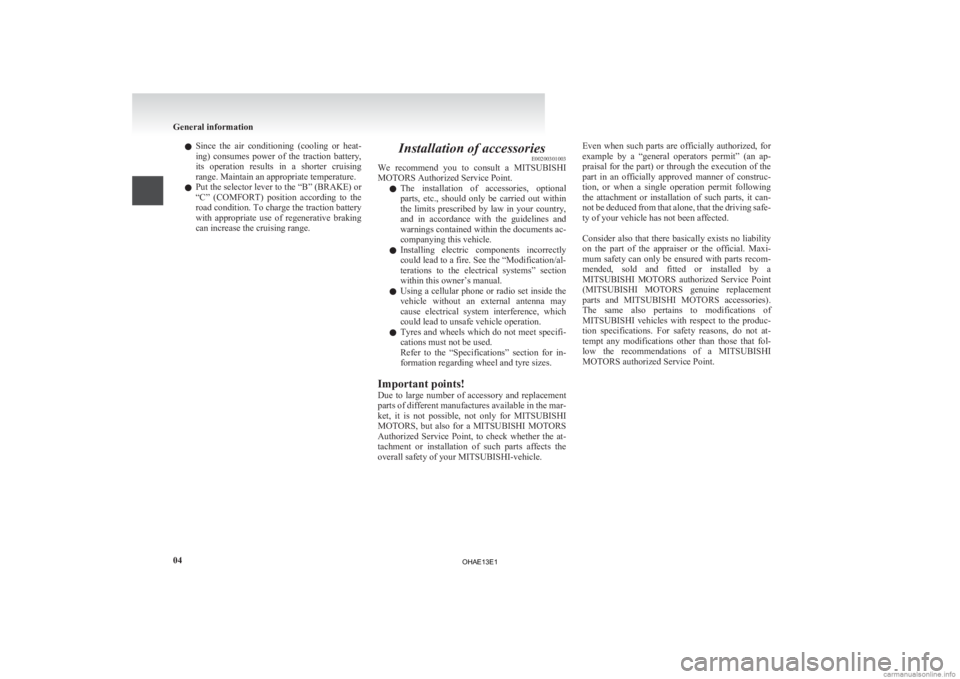
l
Since the air conditioning (cooling or heat-
ing) consumes power of the traction battery,
its operation results in a shorter cruising
range. Maintain an appropriate temperature.
l Put the selector lever to the “B” (BRAKE) or
“C” (COMFORT) position according to the
road condition. To charge the traction battery
with appropriate use of regenerative braking
can increase the cruising range. Installation of accessories
E00200301003
We
recommend you to consult a MITSUBISHI
MOTORS Authorized Service Point.
l The installation of accessories, optional
parts, etc., should only be carried out within
the limits prescribed by law in your country,
and in accordance with the guidelines and
warnings contained within the documents ac-
companying this vehicle.
l Installing electric components incorrectly
could lead to a fire. See the “Modification/al-
terations to the electrical systems” section
within this owner’s manual.
l Using a cellular phone or radio set inside the
vehicle without an external antenna may
cause electrical system interference, which
could lead to unsafe vehicle operation.
l Tyres and wheels which do not meet specifi-
cations must not be used.
Refer to the “Specifications” section for in-
formation regarding wheel and tyre sizes.
Important points!
Due to large number of accessory and replacement
parts of different manufactures available in the mar-
ket, it is not possible, not only for MITSUBISHI
MOTORS, but also for a MITSUBISHI MOTORS
Authorized Service Point, to check whether the at-
tachment or installation of such parts affects the
overall safety of your MITSUBISHI-vehicle.
Even when such parts are officially authorized, for
example
by a “general operators permit” (an ap-
praisal for the part) or through the execution of the
part in an officially approved manner of construc-
tion, or when a single operation permit following
the attachment or installation of such parts, it can-
not be deduced from that alone, that the driving safe-
ty of your vehicle has not been affected.
Consider also that there basically exists no liability
on the part of the appraiser or the official. Maxi-
mum safety can only be ensured with parts recom-
mended, sold and fitted or installed by a
MITSUBISHI MOTORS authorized Service Point
(MITSUBISHI MOTORS genuine replacement
parts and MITSUBISHI MOTORS accessories).
The same also pertains to modifications of
MITSUBISHI vehicles with respect to the produc-
tion specifications. For safety reasons, do not at-
tempt any modifications other than those that fol-
low the recommendations of a MITSUBISHI
MOTORS authorized Service Point. General information
04
OHAE13E1
Page 30 of 258
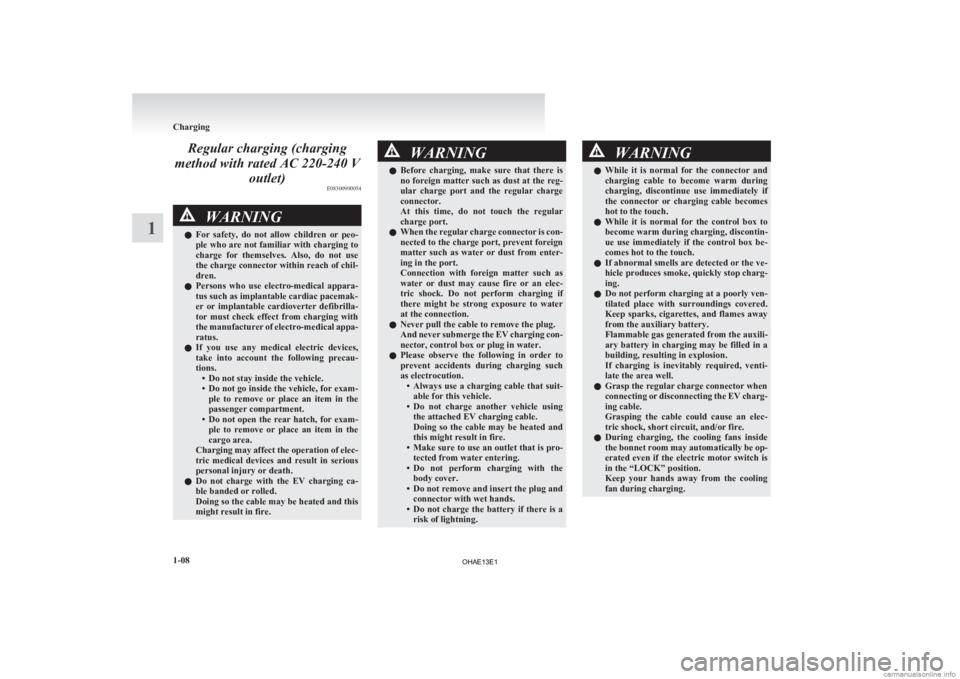
Regular charging (charging
method with rated AC 220-240 V outlet) E08300900054WARNING
l For safety, do not allow children or peo-
ple who are not familiar with charging to
charge for themselves. Also, do not use
the charge connector within reach of chil-
dren.
l Persons who use electro-medical appara-
tus such as implantable cardiac pacemak-
er or implantable cardioverter defibrilla-
tor must check effect from charging with
the manufacturer of electro-medical appa-
ratus.
l If you use any medical electric devices,
take into account the following precau-
tions.
• Do not stay inside the vehicle.
• Do not go inside the vehicle, for exam-ple to remove or place an item in the
passenger compartment.
• Do not open the rear hatch, for exam- ple to remove or place an item in the
cargo area.
Charging may affect the operation of elec-
tric medical devices and result in serious
personal injury or death.
l Do not charge with the EV charging ca-
ble banded or rolled.
Doing so the cable may be heated and this
might result in fire. WARNING
l Before
charging, make sure that there is
no foreign matter such as dust at the reg-
ular charge port and the regular charge
connector.
At this time, do not touch the regular
charge port.
l When the regular charge connector is con-
nected to the charge port, prevent foreign
matter such as water or dust from enter-
ing in the port.
Connection with foreign matter such as
water or dust may cause fire or an elec-
tric shock. Do not perform charging if
there might be strong exposure to water
at the connection.
l Never pull the cable to remove the plug.
And never submerge the EV charging con-
nector, control box or plug in water.
l Please observe the following in order to
prevent accidents during charging such
as electrocution.
• Always use a charging cable that suit-able for this vehicle.
• Do not charge another vehicle using the attached EV charging cable.
Doing so the cable may be heated and
this might result in fire.
• Make sure to use an outlet that is pro- tected from water entering.
• Do not perform charging with the body cover.
• Do not remove and insert the plug and connector with wet hands.
• Do not charge the battery if there is a risk of lightning. WARNING
l While it is normal for the connector and
charging cable to become warm during
charging, discontinue use immediately if
the connector or charging cable becomes
hot to the touch.
l While it is normal for the control box to
become warm during charging, discontin-
ue use immediately if the control box be-
comes hot to the touch.
l If abnormal smells are detected or the ve-
hicle produces smoke, quickly stop charg-
ing.
l Do not perform charging at a poorly ven-
tilated place with surroundings covered.
Keep sparks, cigarettes, and flames away
from the auxiliary battery.
Flammable gas generated from the auxili-
ary battery in charging may be filled in a
building, resulting in explosion.
If charging is inevitably required, venti-
late the area well.
l Grasp the regular charge connector when
connecting or disconnecting the EV charg-
ing cable.
Grasping the cable could cause an elec-
tric shock, short circuit, and/or fire.
l During charging, the cooling fans inside
the bonnet room may automatically be op-
erated even if the electric motor switch is
in the “LOCK” position.
Keep your hands away from the cooling
fan during charging. Charging
1-08
1
OHAE13E1
Page 35 of 258

WARNING
l When the quick charge connector is con-
nected to the quick charge port, prevent
foreign matter such as water or dust
from entering in the port.
Connection with foreign matter such as
water or dust may cause fire or an elec-
tric shock. Do not perform charging if
there might be strong exposure to water
at the connection.
l During charging, the cooling fans inside
the bonnet room may automatically be op-
erated even if the electric motor switch is
in the “LOCK” position.
Keep your hands away from the cooling
fan during charging.
NOTE l If
the charge connector is not easily connec-
ted to the charge port due to foreign material
entering, never force the connection. Doing
so could damage the charging equipment or
the vehicle. Contact a MITSUBISHI
MOTORS Authorized Service Point.
l The quick charger might be installed in the
public parking space, some chargers are not
suitable for this vehicle. Check the manual of
each quick charger when charging.
l The charge connector and the EV charging ca-
ble stick out of the vehicle body while charg-
ing, so be careful that your body does not get
stuck with them or they do not touch the next
vehicle. l
The
vehicle equipped with a quick charge
port is compatible with most CHAdeMO (Jap-
anese industry standard) connectors on charg-
ing stations.
l Make sure to lock the doors to prevent theft,
etc. during charging.
1. Fully apply the parking brake and move the selector lever to the “P” (PARK) position.
2. Stop the electric devices such as lamps, air conditioning, etc. and turn the electric motor
switch to the “LOCK” position.
3. Pull the quick charging lid opener (A) at the bottom left/right of the driver’s seat to open
the quick charging lid (B) at the left rear side
of the vehicle. 4. Press the tab (C) to open the inner lid (D). WARNING
l Do
not touch the metal terminal of the
quick charge port (E) and the quick
charge connector.
Doing so could cause an electric shock and/
or malfunction. CAUTION
l
Be sure to insert the quick charge connec-
tor
straight into the quick charge port
right up to the base.
Failure to do so may result in the traction
battery not charging or could cause dam-
age to the charging equipment.
l Do not leave for a long time with the in-
ner lid opened. It becomes impossible to
charge if a foreign material is entered to
the quick charge port. Charging
1-13 1
OHAE13E1
Page 36 of 258
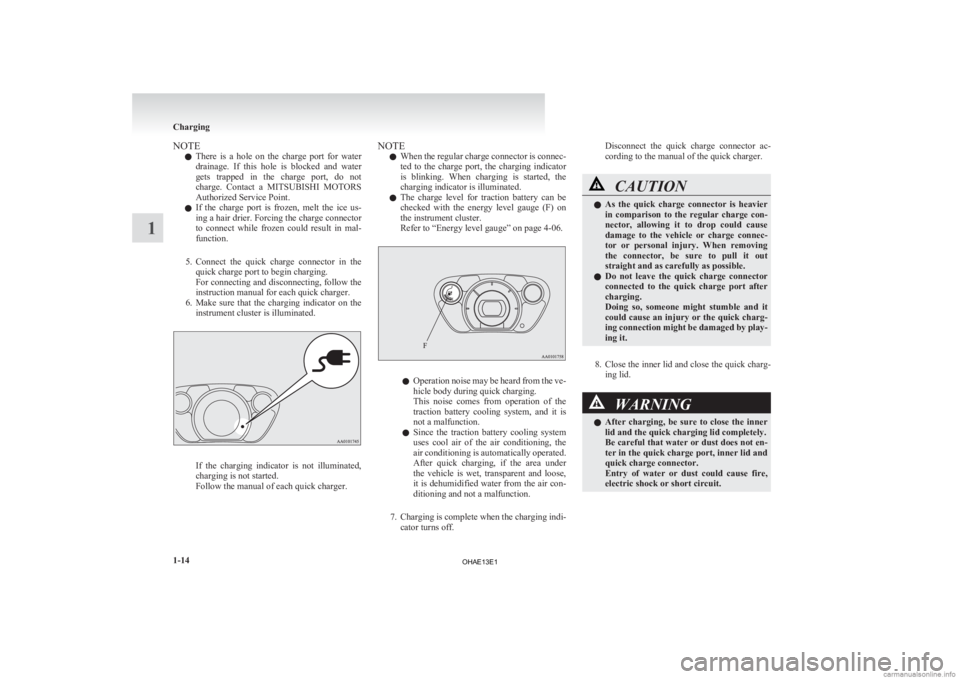
NOTE
l There
is a hole on the charge port for water
drainage. If this hole is blocked and water
gets trapped in the charge port, do not
charge. Contact a MITSUBISHI MOTORS
Authorized Service Point.
l If the charge port is frozen, melt the ice us-
ing a hair drier. Forcing the charge connector
to connect while frozen could result in mal-
function.
5. Connect the quick charge connector in the quick charge port to begin charging.
For connecting and disconnecting, follow the
instruction manual for each quick charger.
6. Make sure that the charging indicator on the instrument cluster is illuminated. If the charging indicator is not illuminated,
charging is not started.
Follow the manual of each quick charger. NOTE
l When
the regular charge connector is connec-
ted to the charge port, the charging indicator
is blinking. When charging is started, the
charging indicator is illuminated.
l The charge level for traction battery can be
checked with the energy level gauge (F) on
the instrument cluster.
Refer to “Energy level gauge” on page 4-06. l
Operation
noise may be heard from the ve-
hicle body during quick charging.
This noise comes from operation of the
traction battery cooling system, and it is
not a malfunction.
l Since the traction battery cooling system
uses cool air of the air conditioning, the
air conditioning is automatically operated.
After quick charging, if the area under
the vehicle is wet, transparent and loose,
it is dehumidified water from the air con-
ditioning and not a malfunction.
7. Charging is complete when the charging indi- cator turns off. Disconnect the quick charge connector ac-
cording to the manual of the quick charger. CAUTION
l
As
the quick charge connector is heavier
in comparison to the regular charge con-
nector, allowing it to drop could cause
damage to the vehicle or charge connec-
tor or personal injury. When removing
the connector, be sure to pull it out
straight and as carefully as possible.
l Do not leave the quick charge connector
connected to the quick charge port after
charging.
Doing so, someone might stumble and it
could cause an injury or the quick charg-
ing connection might be damaged by play-
ing it.
8. Close
the inner lid and close the quick charg- ing lid. WARNING
l After
charging, be sure to close the inner
lid and the quick charging lid completely.
Be careful that water or dust does not en-
ter in the quick charge port, inner lid and
quick charge connector.
Entry of water or dust could cause fire,
electric shock or short circuit. Charging
1-14
1
OHAE13E1
Page 42 of 258
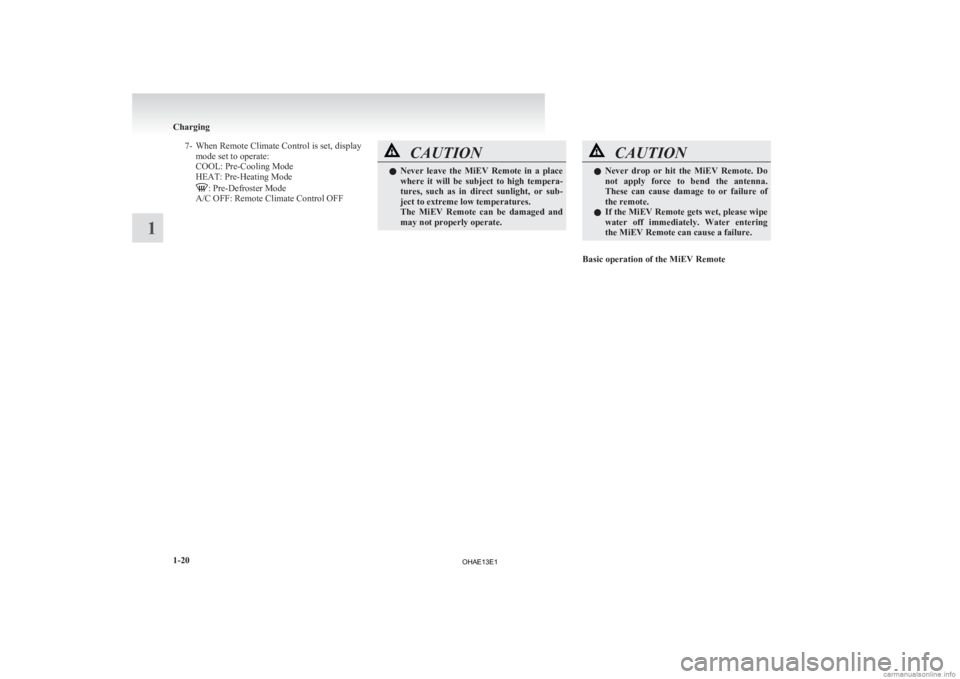
7- When Remote Climate Control is set, display
mode set to operate:
COOL: Pre-Cooling Mode
HEAT: Pre-Heating Mode : Pre-Defroster Mode
A/C OFF: Remote Climate Control OFF CAUTION
l
Never
leave the MiEV Remote in a place
where it will be subject to high tempera-
tures, such as in direct sunlight, or sub-
ject to extreme low temperatures.
The MiEV Remote can be damaged and
may not properly operate. CAUTION
l
Never drop or hit the MiEV Remote. Do
not apply force to bend the antenna.
These can cause damage to or failure of
the remote.
l If the MiEV Remote gets wet, please wipe
water off immediately. Water entering
the MiEV Remote can cause a failure.
Basic operation of the MiEV Remote Charging
1-20
1
OHAE13E1
Page 50 of 258

NOTE
l If
the manual charging switch (H) is pressed,
the symbol of MiEV Remote will blink.
The Remote Climate Control is also stopped.
3. Cancelling
Charging Timer is complete,
and the MiEV Remote will sound two dif-
ferent melodies.
4. Turn off the MiEV Remote. Refer to “To turn the MiEV Remote ON/OFF” on
page 1-24.
B- By operating the electric motor switch on the vehicle
Turn the electric motor switch to the “ACC”
or “ON” position, then turn back to the
“LOCK” position
Cancelling the Charging Timer is now com-
plete. Remote Climate Control
E08302800015 WARNING
l The
Remote Climate Control, even when
set, cannot be relied upon to maintain
safe vehicle cabin temperatures while the
vehicle is stopped or parked. Never leave
children or persons requiring supervision/
nursing unattended inside the vehicle.
The temperature inside the vehicle could
become extremely high or low resulting
in a risk of heat stroke or hyperthermia
that could result in death.
In addition, children can activate
switches and controls, resulting in injury
or a fatal accident.
l While the Remote Climate Control is acti-
vated, keep away from the cooling fan un-
der the bonnet, since the cooling fan may
automatically operate even if the electric
motor switch is in the “LOCK” position.
NOTE l The
Remote Climate Control works regard-
less of the position of the air conditioning
switch or dial on the vehicle. While the Re-
mote Climate Control is activated, the air con-
ditioning switch or dial on the vehicle will
not affect operation of the cooler, heater or
defroster.
l The Remote Climate Control will automati-
cally stop 30 minutes after the Remote Cli-
mate Control has been set. l
The
Remote Climate Control is operated by
electric power supplied through the EV charg-
ing cable (regular charger).
l Under the following conditions, the effect of
the Remote Climate Control can be decreased.
• When the outside temperature is very high.
• When the sunlight is strong.
• When the outside temperature is very low.
l When the Remote Climate Control is activa-
ted while charging the traction battery, the
time required to fully charge the traction bat-
tery will become longer or the amount of
charge may decrease if the OFF timer has
been set.
l While the Remote Climate Control is activa-
ted, if a heated seat switch is ON, the heated
seat will operate.
To operate the Remote Climate Control E08302900016
The following conditions must be met to operate
the Remote Climate Control.
l Selector lever: P (PARK) position.
l Electric motor switch: LOCK position.
l EV
charging cable (regular charger): Connec-
ted.
l Quick charging: Not used.
l Traction Battery Level Indicator: Shows one
bar or more.
Refer to “Traction Battery Level Indicator”
on page 1-30.
l All doors and the liftgate: Closed. Charging
1-28
1
OHAE13E1
Page 51 of 258

WARNING
l Improper charging can result in fire, prop-
erty damage, and serious injury or death.
Carefully read and follow instructions in
“Basic knowledge for charging” on page
1-04 and “Charging method with rated
AC 220-240 V outlet” on page 1-09.
1. Start
charging. Refer to “Charging method with rated AC 220-240 V outlet” on page
1-09.
2. Turn on the MiEV Remote. Refer to “To turn the MiEV Remote ON/OFF” on page
1-24.
3. Press the MODE switch (E) to change the mode to Remote Climate Control (3). 1- Shown the ON timer
2-
Shown the OFF timer
3- Shown the Remote Climate Control
4. Select a desired mode by pressing UP switch(C) or DOWN switch (D). The modes will be changed in the order from
1 to 4 by pushing the UP switch.
1- COOL: Pre-Cooling Mode
2-
HEAT: Pre-Heating Mode
3- : Pre-Defroster Mode
4-
A/C OFF: Remote Climate Control OFF
5. Press the power/communication switch (B) for less than 1 second to send the setting to
the vehicle. The MiEV Remote will sound
melodies on transmission and reception. NOTE
l The
melodies can be turned off. Refer to “To
turn on/off melody and buzzer” on page
1-30.
l If a communication error occurs or the MiEV
Remote System is not functioning properly,
the buzzer will sound. Refer to “Display of
MiEV Remote during communicating with
vehicle” on page 1-27.
6. Turn off the MiEV Remote. Refer to “To turn the MiEV Remote ON/OFF” on page
1-24.
To stop the Remote Climate Control E08303000030
The Remote Climate Control can be stopped by ei-
ther of the following methods.
A- By
using the MiEV Remote, after pressing
the manual charging switch (H), press the
power/communication switch (B) for less
than 1 second. Charging
1-29 1
OHAE13E1
Page 59 of 258
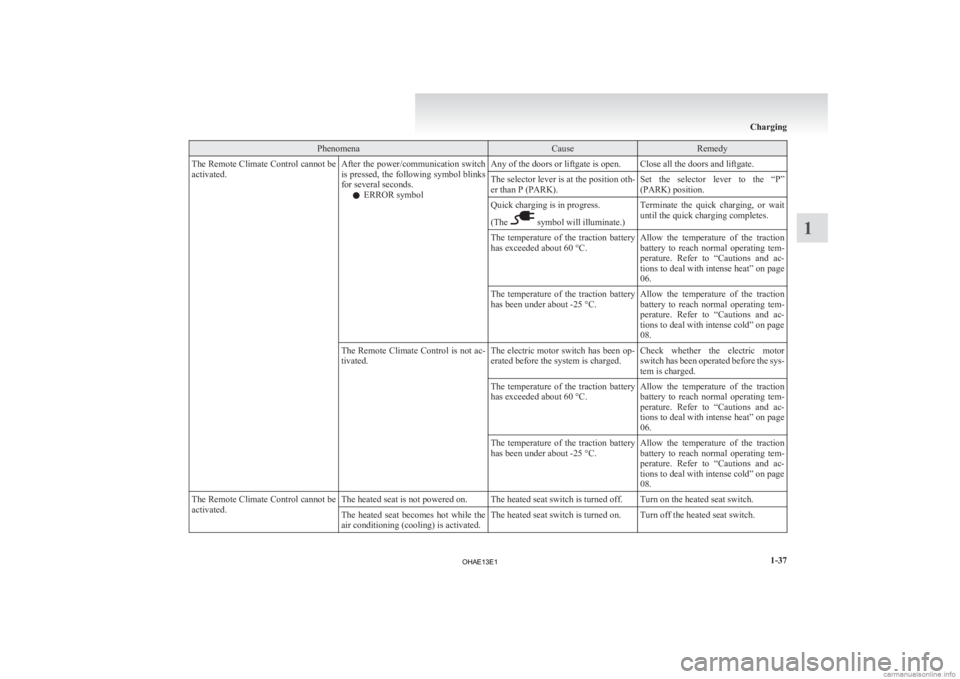
Phenomena Cause Remedy
The Remote Climate Control cannot be
activated. After the power/communication switch
is
pressed, the following symbol blinks
for several seconds.
l ERROR symbol Any of the doors or liftgate is open. Close all the doors and liftgate.
The selector lever is at the position oth-
er than P (PARK).
Set the selector lever to the “P”
(PARK) position.
Quick charging is in progress.
(The symbol will illuminate.)
Terminate the quick charging, or wait
until the quick charging completes.
The temperature of the traction battery
has exceeded about 60 °C. Allow the temperature of the traction
battery
to reach normal operating tem-
perature. Refer to “Cautions and ac-
tions to deal with intense heat” on page
06.
The temperature of the traction battery
has been under about -25 °C. Allow the temperature of the traction
battery
to reach normal operating tem-
perature. Refer to “Cautions and ac-
tions to deal with intense cold” on page
08.
The Remote Climate Control is not ac-
tivated. The electric motor switch has been op-
erated before the system is charged.Check whether the electric motor
switch
has been operated before the sys-
tem is charged.
The temperature of the traction battery
has exceeded about 60 °C. Allow the temperature of the traction
battery
to reach normal operating tem-
perature. Refer to “Cautions and ac-
tions to deal with intense heat” on page
06.
The temperature of the traction battery
has been under about -25 °C. Allow the temperature of the traction
battery
to reach normal operating tem-
perature. Refer to “Cautions and ac-
tions to deal with intense cold” on page
08.
The Remote Climate Control cannot be
activated. The heated seat is not powered on. The heated seat switch is turned off. Turn on the heated seat switch.
The heated seat becomes hot while the
air conditioning (cooling) is activated.The heated seat switch is turned on. Turn off the heated seat switch. Charging
1-37 1
OHAE13E1
Page 107 of 258
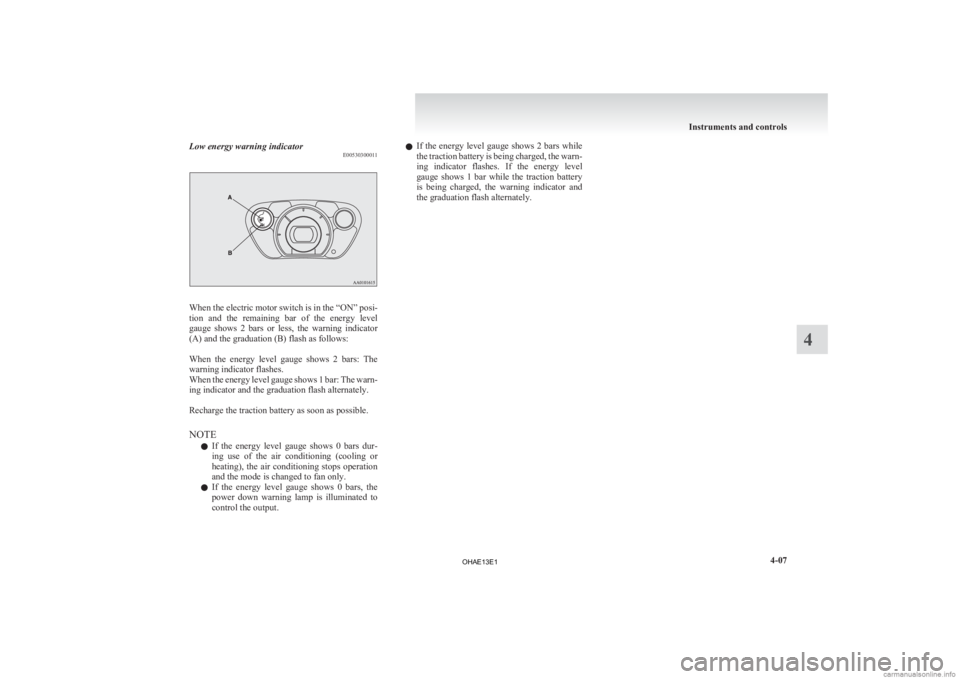
Low energy warning indicator
E00530300011When the electric motor switch is in the “ON” posi-
tion
and the remaining bar of the energy level
gauge shows 2 bars or less, the warning indicator
(A) and the graduation (B) flash as follows:
When the energy level gauge shows 2 bars: The
warning indicator flashes.
When the energy level gauge shows 1 bar: The warn-
ing indicator and the graduation flash alternately.
Recharge the traction battery as soon as possible.
NOTE
l If the energy level gauge shows 0 bars dur-
ing use of the air conditioning (cooling or
heating), the air conditioning stops operation
and the mode is changed to fan only.
l If the energy level gauge shows 0 bars, the
power down warning lamp is illuminated to
control the output. l
If
the energy level gauge shows 2 bars while
the traction battery is being charged, the warn-
ing indicator flashes. If the energy level
gauge shows 1 bar while the traction battery
is being charged, the warning indicator and
the graduation flash alternately. Instruments and controls
4-07 4
OHAE13E1
Page 111 of 258
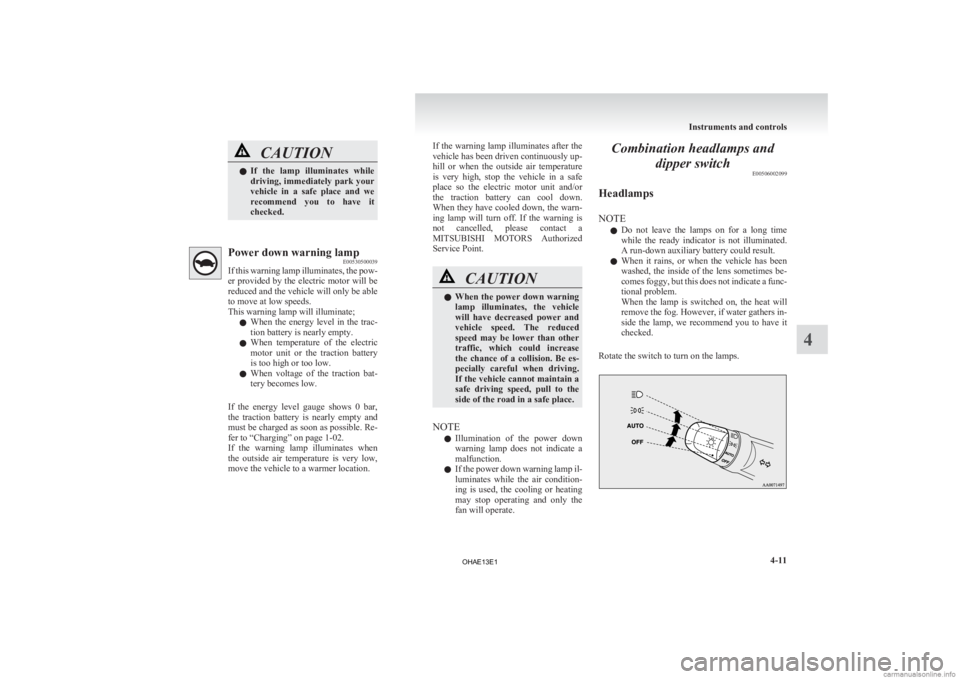
CAUTION
l
If the lamp illuminates while
driving, immediately park your
vehicle in a safe place and we
recommend you to have it
checked. Power down warning lamp
E00530500039
If
this warning lamp illuminates, the pow-
er provided by the electric motor will be
reduced and the vehicle will only be able
to move at low speeds.
This warning lamp will illuminate;
l When the energy level in the trac-
tion battery is nearly empty.
l When temperature of the electric
motor unit or the traction battery
is too high or too low.
l When voltage of the traction bat-
tery becomes low.
If the energy level gauge shows 0 bar,
the traction battery is nearly empty and
must be charged as soon as possible. Re-
fer to “Charging” on page 1-02.
If the warning lamp illuminates when
the outside air temperature is very low,
move the vehicle to a warmer location. If the warning lamp illuminates after the
vehicle has been driven continuously up-
hill
or when the outside air temperature
is very high, stop the vehicle in a safe
place so the electric motor unit and/or
the traction battery can cool down.
When they have cooled down, the warn-
ing lamp will turn off. If the warning is
not cancelled, please contact a
MITSUBISHI MOTORS Authorized
Service Point. CAUTION
l
When
the power down warning
lamp illuminates, the vehicle
will have decreased power and
vehicle speed. The reduced
speed may be lower than other
traffic, which could increase
the chance of a collision. Be es-
pecially careful when driving.
If the vehicle cannot maintain a
safe driving speed, pull to the
side of the road in a safe place.
NOTE l Illumination
of the power down
warning lamp does not indicate a
malfunction.
l If the power down warning lamp il-
luminates while the air condition-
ing is used, the cooling or heating
may stop operating and only the
fan will operate. Combination headlamps and
dipper switch E00506002099
Headlamps
NOTE l Do
not leave the lamps on for a long time
while the ready indicator is not illuminated.
A run-down auxiliary battery could result.
l When it rains, or when the vehicle has been
washed, the inside of the lens sometimes be-
comes foggy, but this does not indicate a func-
tional problem.
When the lamp is switched on, the heat will
remove the fog. However, if water gathers in-
side the lamp, we recommend you to have it
checked.
Rotate the switch to turn on the lamps. Instruments and controls
4-11 4
OHAE13E1